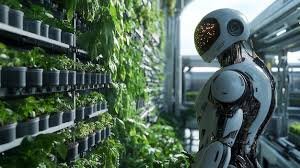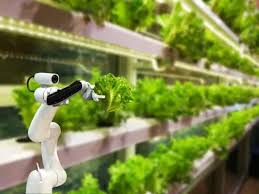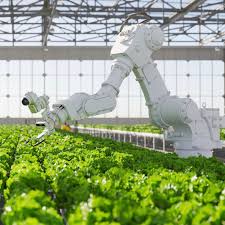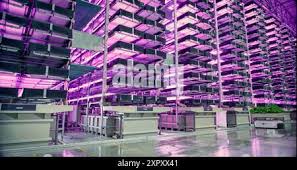
What are Vertical Farms with AI and Robotics?
Vertical farming is a method of growing crops in stacked layers or vertically inclined surfaces, often integrated into urban settings. This farming method contrasts with traditional farming by maximizing limited space, utilizing controlled-environment agriculture (CEA) to optimize conditions for plant growth. When combined with AI (artificial intelligence) and robotics, vertical farms become highly automated and efficient, allowing for precision agriculture on a large scale.
In vertical farms, crops are grown in indoor facilities, such as warehouses or skyscrapers, using hydroponic or aeroponic systems, which means they don’t require soil. AI and robotics play crucial roles in monitoring environmental factors, managing resources, and automating tasks such as planting, harvesting, and crop care.
How AI and Robotics Enhance Vertical Farms

- Automation of Planting and Harvesting:
- Robots equipped with sensors and actuators can plant, prune, and harvest crops. These robots are designed to work around the clock, increasing efficiency and reducing the need for manual labor.
- AI-based systems control robotic arms and machines to carefully tend to each plant according to its specific growth needs.
- Monitoring Environmental Conditions:
- AI algorithms continuously analyze environmental data—such as temperature, humidity, light, and CO2 levels—and adjust conditions in real-time for optimal crop growth.
- Robotics and IoT devices can monitor soil moisture, nutrient levels, and plant health, ensuring that each plant receives exactly what it needs.
- Data Analytics: AI is used to process large datasets from sensors and cameras, identifying issues like disease, pests, or nutrient deficiencies early on.
- Precision Agriculture:
- With AI, vertical farms can implement precision agriculture, which involves tailoring farming techniques to individual plants’ needs. By using advanced machine learning models, the system can predict growth patterns, optimize nutrient delivery, and forecast yields more accurately.
- Robotics can deliver precise amounts of water, nutrients, and light, ensuring that resources are not wasted, and each plant thrives.
- Predictive Analytics for Crop Management:
- AI tools help predict the health and growth patterns of crops, enabling farm managers to optimize crop schedules and plan future harvests.
- Predictive modeling allows for the identification of potential risks—such as pest infestations or disease outbreaks—before they become significant problems, helping farmers take preventative measures.
- Energy and Resource Optimization:
- AI and robotics help in maximizing resource use, such as water, energy, and nutrients, minimizing waste and ensuring that the farm operates sustainably.
- Energy-efficient LED lighting controlled by AI systems mimics sunlight and is optimized for plant growth, while also reducing the energy cost of the farm.
- Supply Chain Optimization:
- AI-based software can predict demand patterns, enabling farms to produce the right amount of crops at the right time. This helps avoid overproduction or underproduction, reducing waste and ensuring that products are always available for sale.
Key Technologies in Vertical Farms with AI and Robotics

- Robotic Harvesting Systems:
- Robots like Octinion’s Rubion or FFRobots’ harvesting robots are designed to pick delicate crops such as strawberries and leafy greens with great precision, minimizing damage during harvesting.
- AI and Computer Vision:
- Computer vision systems use cameras and sensors to monitor crops. AI software analyzes images to detect issues such as diseases, pests, and nutrient deficiencies.
- Deep learning models are employed to process visual data, allowing systems to track crop growth and predict the best time to harvest.
- IoT Sensors:
- IoT (Internet of Things) sensors monitor real-time environmental data, including temperature, humidity, light levels, CO2, and pH. These sensors feed data to AI systems that make automated adjustments to the farm’s systems.
- Automated Plant Care Systems:
- Robotic arms equipped with specialized tools for trimming, pruning, or even pollinating plants, are used to optimize plant care without human intervention.
Benefits of Vertical Farms with AI and Robotics
- Increased Crop Yield:
- Vertical farming increases productivity by utilizing space more efficiently. By stacking crops and optimizing the growing environment with AI, vertical farms can yield much more produce per square foot than traditional farming.
- Sustainability and Resource Efficiency:
- With AI managing water usage and robotics ensuring that crops get the right amount of nutrients and care, these farms use far less water and land compared to traditional agriculture.
- Energy efficiency is another advantage, as AI systems can control temperature, light, and humidity, optimizing energy use.
- By eliminating the need for pesticides and reducing transportation (since these farms can be placed near urban centers), vertical farms also minimize their environmental footprint.
- Faster Growing Cycles:
- The controlled environment in vertical farms allows for year-round production, leading to faster growth cycles and higher turnover rates for crops. AI systems ensure that conditions are always ideal, reducing the time required for crops to reach maturity.
- Less Dependency on Climate:
- Since vertical farms operate indoors, they are less impacted by external factors like weather conditions, pests, or diseases. This makes crop production more predictable and stable, even in regions with extreme climates or poor soil.
- Reduction in Food Miles:
- By placing vertical farms within or near urban areas, the need for long-distance transportation is minimized. This reduces the carbon footprint associated with food distribution, leading to fresher produce and lower transportation costs.
- Job Creation and Innovation:
- Although vertical farms reduce the need for manual labor in some areas, they also create new jobs in robotics, AI development, farm management, and systems maintenance. These innovations push the boundaries of technology and agriculture, driving economic growth in tech-heavy sectors.
Challenges and Limitations
- High Initial Investment:
- The capital required to set up vertical farms with advanced AI and robotic systems can be high. While operational costs may be lower in the long term, the initial infrastructure investment may be a barrier for some startups or regions.
- Technical Complexity:
- Integrating AI, robotics, and other advanced systems requires specialized expertise and ongoing maintenance. Additionally, any system failures—whether in AI models or robotics—could disrupt the entire operation.
- Energy Demands:
- Despite being energy-efficient, vertical farms still require a significant amount of energy to power lights, sensors, cooling systems, and robotics. If the energy comes from non-renewable sources, it could offset some of the sustainability benefits.
- Scalability:
- Scaling vertical farms from small operations to large commercial farms that can feed millions of people may be challenging. Each farm needs to be designed and optimized for local conditions, which can add complexity to expansion efforts.
Companies Leading the Way
- Plenty: A leading vertical farming company, using AI and robotics to grow food in urban areas with minimal water and land usage.
- Bowery Farming: Another prominent vertical farm, integrating AI-driven systems to optimize plant health, monitor growth patterns, and deliver personalized care to crops.
- Aerofarms: Known for using aeroponic growing systems (no soil, minimal water), they use advanced robotics and AI for monitoring and managing plant growth.
The Future of Vertical Farms with AI and Robotics

As AI and robotics continue to advance, the potential for vertical farms to become a significant part of the global food system grows. These farms could become essential in tackling issues like food security, climate change, and urbanization, all while reducing the environmental impact of traditional agriculture. With continued research and development, the integration of AI and robotics will further optimize these systems, making them more affordable, scalable, and efficient.
Conclusion
Vertical farming with AI and robotics represents a cutting-edge solution to many challenges faced by traditional agriculture. By optimizing resource use, improving yields, and reducing environmental impact, these farms could become a cornerstone of sustainable food production in the future. However, overcoming challenges related to cost, scalability, and energy consumption will be key to making these systems widespread and accessible on a global scale.

